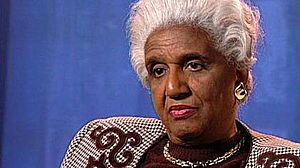Audrey Grevious facts for kids
Quick facts for kids
Audrey Grevious
|
|
|---|---|
 |
|
| Born |
Audrey Louise Ross
September 30, 1930 Lexington, Kentucky
|
| Died | January 6, 2017 (aged 86) |
| Known for | president of the Lexington NAACP. |
Audrey Louise Grevious (born Audrey Louise Ross; September 30, 1930 – January 6, 2017) was an important leader in the Civil Rights Movement in Lexington and the state of Kentucky. She worked hard to fight for equal rights for African Americans.
Contents
Growing Up in Lexington
Audrey Louise Ross was born in Lexington, Kentucky. She grew up with her mother, Martha Ross, and her younger brother, Robert. Even though her father didn't live with them, Audrey felt like the whole African American community helped raise her.
She once said, "When I hear people talk bad about what happens to children who are raised by one parent, you know, I look at them like they're crazy ... I can look at myself and at my brother and say that our mother did an excellent job of raising us."
Audrey's mother worked as a domestic servant, like a nanny. Audrey spent her youth helping her mother and focusing on her studies. She went to Constitution Elementary School and then Dunbar Junior and High School. These were schools where Black and White students were kept separate, known as segregated schools.
Audrey always got good grades. She believed her mother taught her to be the best she could be. Her mother told them they needed goals and to work hard to reach them.
Audrey was also active in Girl Scouts. She enjoyed social events at the Charles Young Community Center. She loved dances, arts and crafts, and talent shows. From a young age, she wanted to be a teacher. Her math teachers at Dunbar, Mrs. Claire Winda Taylor and Mrs. Ada Taylor, inspired her. Audrey graduated in 1948. She stayed involved with the Dunbar Alumni Association, which helps students with scholarships.
College and Early Activism
After high school, Audrey went to Kentucky State University in Frankfort, Kentucky, in 1948. She came home every weekend. Seeing how hard her mother worked, Audrey left college the next year to get a job. She worked as a secretary for the Town Crier, a Black newspaper in Lexington. This job showed her how much racism and unfair treatment existed in Kentucky.
In 1955, her brother returned from the military. He had enough money to help himself, his wife, and Audrey go back to Kentucky State. Audrey graduated in 1957 with a degree in elementary education. While in college, she joined the National Association for the Advancement of Colored People (NAACP) in Lexington. She was elected as the secretary.
After graduating, Audrey became the president of the Lexington NAACP. She went to an NAACP meeting in New York. There, she and some members from Ohio decided to do an experiment. They wanted to see how White Americans would treat them.
Audrey and some male NAACP members drove from New York to Lexington and back. On the way to Kentucky, they drove a simple car and wore business clothes. When they stopped, many White business owners refused to serve them. Some offered food in a box if they went to the back door, but they refused.
On the way back to New York, the NAACP rented a fancy limousine. Audrey wore furs and jewelry. One young man was dressed in a suit, and another was the chauffeur. They stopped at the same places. This time, they were served everywhere except one place. Audrey realized that people treated them differently because of how they looked. They thought she might be a rich foreigner. This experience made her even more determined to fight for change. She said it got her "one hundred and ten percent" into the Civil Rights Movement.
Fighting for Equality
Audrey started teaching at a school for young people who had gotten into trouble. It was called Kentucky Village Reform School. She noticed that the school was segregated. Black and White students ate in separate cafeterias. Audrey bravely took her Black students to eat in the Whites-only cafeteria. She met with the superintendent many times. She was never fired, and she eventually became the head principal.
While working, Audrey stayed very active in the NAACP. She led many "picket line" protests. These were peaceful demonstrations where people stood outside businesses with signs. They protested against Lexington businesses that wouldn't hire Black people or serve them. Her actions helped Black people get jobs they had never held before. All her protests were peaceful, without violence.
Audrey worked closely with Julia Lewis, who led the local Congress on Racial Equality (CORE) group. Audrey later became the vice-president of CORE. She helped bring the NAACP and CORE together to work for fairness and equal rights.
Through her leadership in many protests, Mrs. Grevious helped bring about big changes in Lexington. These changes were hard to achieve in many other parts of the South. She retired from teaching after becoming principal at Maxwell Elementary School. She remained an active member of the NAACP throughout her life.
Audrey Grevious shared her life story in several interviews. These interviews are kept at the Louie B. Nunn Center for Oral History at the University of Kentucky Libraries. She passed away on January 6, 2017, at 86 years old.
See Also
Additional resources
- Johnson, Larry. "An Unsung Hero: Audrey Rice Grevious". Kentucky Women in the Civil Rights Era. Accessed December 5, 2010.

